《动物免疫学》课程PPT教学课件(讲稿)抗原、受体和球蛋白 Antigens, Receptors and Immunoglobulins
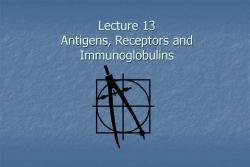
Lecture 13 Antigens,Receptors and Immunoglobulins
Lecture 13 Antigens, Receptors and Immunoglobulins

Antigenic Determinants(Epitopes) Haptenic determinant Conformational Antigenic Determinant ●舍 Sequential antigenic deferminant
Antigenic Determinants (Epitopes)
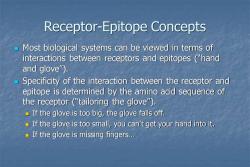
Receptor-Epitope Concepts Most biological systems can be viewed in terms of interactions between receptors and epitopes (hand and glove"). Specificity of the interaction between the receptor and epitope is determined by the amino acid sequence of the receptor ("tailoring the glove"). If the glove is too big,the glove falls off. If the glove is too small,you can't get your hand into it. If the glove is missing fingers
Receptor-Epitope Concepts ◼ Most biological systems can be viewed in terms of interactions between receptors and epitopes (“hand and glove”). ◼ Specificity of the interaction between the receptor and epitope is determined by the amino acid sequence of the receptor (“tailoring the glove”). ◼ If the glove is too big, the glove falls off. ◼ If the glove is too small, you can’t get your hand into it. ◼ If the glove is missing fingers…
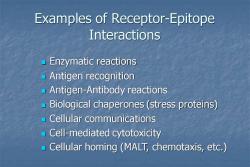
Examples of Receptor-Epitope Interactions Enzymatic reactions Antigen recognition Antigen-Antibody reactions Biological chaperones(stress proteins) Cellular communications Cell-mediated cytotoxicity Cellular homing (MALT,chemotaxis,etc.)
Examples of Receptor-Epitope Interactions ◼ Enzymatic reactions ◼ Antigen recognition ◼ Antigen-Antibody reactions ◼ Biological chaperones (stress proteins) ◼ Cellular communications ◼ Cell-mediated cytotoxicity ◼ Cellular homing (MALT, chemotaxis, etc.)

Basic Immunoglobulin Structure light chain disufide bridges heavy chain @1997 Current Biology Ltd./Garland Publishing,Inc
Basic Immunoglobulin Structure

The Prototype Immunoglobulin Molecule Fab Heavy Chains(five VH types:a,y,u,8,s) Light Chains (two CH1 types:7 and Fab fragment 42 Fc fragment Fc Constant and CH3 variable regions Carbohydrate Disulfide linkages
The Prototype Immunoglobulin Molecule Fab Fc VH CH1 CH2 CH3 VL CL ◼ Heavy Chains (five types: ) ◼ Light Chains (two types: and ) ◼ Fab fragment ◼ Fc fragment ◼ Constant and variable regions ◼ Carbohydrate ◼ Disulfide linkages
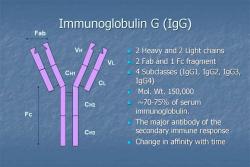
Immunoglobulin G(IgG) Fab 2 Heavy and 2 Light chains VL 2 Fab and 1 Fc fragment CH1 4 Subclasses (IgG1,IgG2,IgG3, CL IgG4) ▣Mol.Wt.150,000 CH2 ~70-75%of serum Fc immunoglobulin. The major antibody of the CH3 secondary immune response Change in affinity with time
Immunoglobulin G (IgG) ◼ 2 Heavy and 2 Light chains ◼ 2 Fab and 1 Fc fragment ◼ 4 Subclasses (IgG1, IgG2, IgG3, IgG4) ◼ Mol. Wt. 150,000 ◼ ~70-75% of serum immunoglobulin. ◼ The major antibody of the secondary immune response ◼ Change in affinity with time Fab Fc VH CH1 CH2 CH3 VL CL
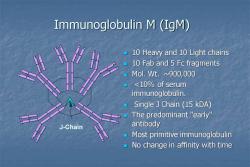
Immunoglobulin M (IgM) 10 Heavy and 10 Light chains 10 Fab and 5 Fc fragments ▣Mol.Wt.~900,000 <10%of serum immunoglobulin. Single Chain(15 kDA) The predominant "early" J-Chain antibody Most primitive immunoglobulin No change in affinity with time
Immunoglobulin M (IgM) ◼ 10 Heavy and 10 Light chains ◼ 10 Fab and 5 Fc fragments ◼ Mol. Wt. ~900,000 ◼ <10% of serum immunoglobulin. ◼ Single J Chain (15 kDA) ◼ The predominant "early" antibody ◼ Most primitive immunoglobulin ◼ No change in affinity with time J-Chain
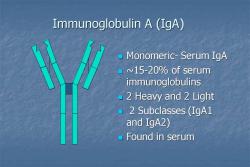
Immunoglobulin A (IgA) Monomeric-Serum IgA ~15-20%of serum immunoglobulins 2 Heavy and 2 Light ·2 Subclasses(IgA1 and IgA2) Found in serum
Immunoglobulin A (IgA) ◼ Monomeric- Serum IgA ◼ ~15-20% of serum immunoglobulins ◼ 2 Heavy and 2 Light ◼ 2 Subclasses (IgA1 and IgA2) ◼ Found in serum
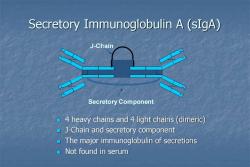
Secretory Immunoglobulin A(sIgA) J-Chain Secretory Component 4 heavy chains and 4 light chains (dimeric) J-Chain and secretory component The major immunoglobulin of secretions Not found in serum
Secretory Immunoglobulin A (sIgA) ◼ 4 heavy chains and 4 light chains (dimeric) ◼ J-Chain and secretory component ◼ The major immunoglobulin of secretions ◼ Not found in serum Secretory Component J-Chain
按次数下载不扣除下载券;
注册用户24小时内重复下载只扣除一次;
顺序:VIP每日次数-->可用次数-->下载券;
- 《动物免疫学》课程PPT教学课件(讲稿)抗体产生的多样性(英文).ppt
- 《动物免疫学》课程PPT教学课件(讲稿)抗体-抗原反应(Antibody-Antigen Reactions).ppt
- 《动物免疫学》课程PPT教学课件(讲稿)抗原(Antigen, Ag).ppt
- 《动物免疫学》课程PPT教学课件(讲稿)免疫自动化仪器分析.ppt
- 《动物免疫学》课程PPT教学课件(讲稿)免疫耐受 Immunological Tolerance.ppt
- 《动物免疫学》课程PPT教学课件(讲稿)免疫系统的遗传学(Genetics of the Immune system).ppt
- 《动物免疫学》课程PPT教学课件(讲稿)免疫系统(The Immune System).ppt
- 《动物免疫学》课程PPT教学课件(讲稿)免疫球蛋白(Immunoglobulin, Ig).ppt
- 《动物免疫学》课程PPT教学课件(讲稿)免疫标记技术及应用.ppt
- 《动物免疫学》课程PPT教学课件(讲稿)免疫应答概述(Immune response).ppt
- 《动物免疫学》课程PPT教学课件(讲稿)免疫学概论.ppt
- 《动物免疫学》课程PPT教学课件(讲稿)免疫学发展简史及展望.ppt
- 《动物免疫学》课程PPT教学课件(讲稿)体液免疫反应 Humoral Immune Response.ppt
- 《动物免疫学》课程PPT教学课件(讲稿)传染与免疫(病原体对机体的感染、机体对感染的预防和治疗).ppt
- 《动物免疫学》课程PPT教学课件(讲稿)主要组织相容性抗原系统(histicompatibility antigen).ppt
- 《动物免疫学》课程PPT教学课件(讲稿)主要组织相容性复合体及其编码分子.ppt
- 《动物免疫学》课程PPT教学课件(讲稿)主要的补体系统缺乏(Primary deficiencies of the complement system).ppt
- 《动物免疫学》课程PPT教学课件(讲稿)T淋巴细胞与特异性细胞免疫.ppt
- 《动物免疫学》课程PPT教学课件(讲稿)Cellular Cooperation and Antigen Recognition.ppt
- 《动物免疫学》课程PPT教学课件(讲稿)IL-8生物活性的检测.ppt
- 西南民族大学:《动物免疫学》课程PPT教学课件(讲稿)抗原抗体反应 antigen-antibody reaction(主讲:岳华).ppt
- 《动物免疫学》课程PPT教学课件(讲稿)B淋巴细胞与特异性体液免疫.ppt
- 《动物免疫学》课程PPT教学课件(讲稿)淋巴细胞抗原识别受体的编码及多样性的产生.ppt
- 《动物免疫学》课程PPT教学课件(讲稿)白细胞分化抗原和黏附分子.ppt
- 《动物免疫学》课程PPT教学课件(讲稿)补体系统(激活、调节、生物学作用).ppt
- 《动物免疫学》课程PPT教学课件(讲稿)补体系统和细胞因子.ppt
- 《动物免疫学》课程PPT教学课件(讲稿)补体系统(The Complement System).ppt
- 《动物免疫学》课程PPT教学课件(讲稿)超敏反应(1)Hypersensitivity Reactions.ppt
- 《动物免疫学》课程PPT教学课件(讲稿)超敏反应 Hypersensitivity.ppt
- 《动物免疫学》课程PPT教学课件(讲稿)超敏反应(2-5型)Hypersensitivity Types II-V.ppt
- 《动物免疫学》课程PPT教学课件(讲稿)非特异性免疫的组成细胞及功能.ppt
- 广东海洋大学:《动物繁殖学》课程教学大纲 Animal Reproduction(打印版).pdf
- 广东海洋大学:《动物繁殖学》课程教学课件(PPT讲稿)第一章 绪论 Animal Reproduction(负责人:安立龙).ppt
- 广东海洋大学:《动物繁殖学》课程授课教案(打印版,主讲:安立龙、巨向红).pdf
- 广东海洋大学:《动物繁殖学》课程教学课件(PPT讲稿)第三章 动物生殖激素及其作用.ppt
- 广东海洋大学:《动物繁殖学》课程教学课件(PPT讲稿)第九章 动物胚胎工程.ppt
- 广东海洋大学:《动物繁殖学》课程教学课件(PPT讲稿)第二章 家畜的生殖器官.ppt
- 广东海洋大学:《动物繁殖学》课程教学课件(PPT讲稿)第五章 雌性动物的发情(母畜的生殖生理).ppt
- 广东海洋大学:《动物繁殖学》课程教学课件(PPT讲稿)第六章 受精、妊娠、分娩.ppt
- 广东海洋大学:《动物繁殖学》课程教学课件(PPT讲稿)第十章 动物繁殖生物技术.ppt
